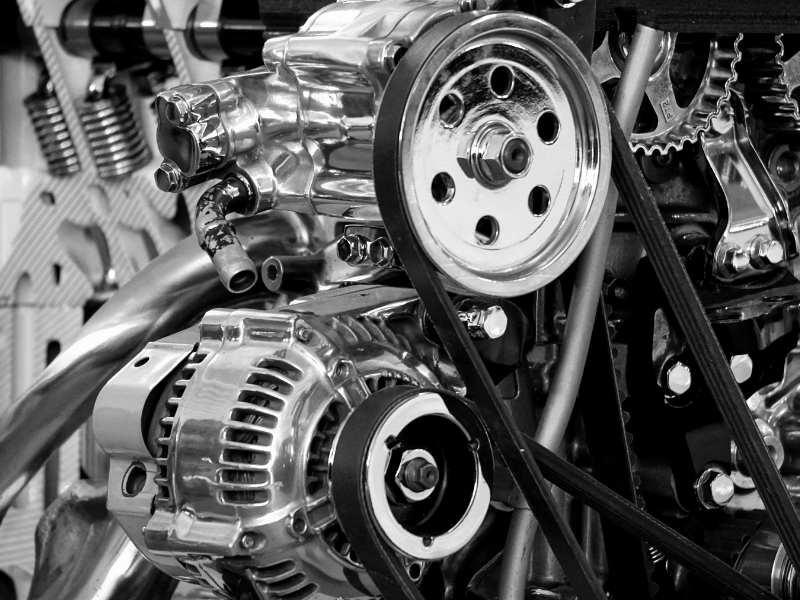If you’ve spent any time around car enthusiasts, you’ll have heard about advancing or retarding the timing of an engine.
There are a variety of reasons to retard an engine. It could be that the gas mileage is too high or the engine may be running rough.
You may find that the power is down or the engine is misfiring.
Whatever the reason, here’s what you should know about retarding an engine.
Table of Contents
What Does it Mean to Retard an Engine?
The term to retard an engine refers to the process of adjusting the timing a little bit so that the sparkplug fires slightly later on the combustion stroke of a 4-stroke engine. If you wished to make the spark appear later, you would advance the timing.

Why Would You Retard an Engine?
There are many reasons why you might want to retard an engine.
But before we go into the reasons, let’s look at how a very basic 4-stroke engine works to understand what adjusting the timing on an engine does.
A 4-stroke engine completes 4 up and down strokes to create power to drive the crankshaft.
1st Stroke
The first stroke starts with the piston at the top of the cylinder. It moves down and draws a mixture of fuel and air into the cylinder. The inlet valve will be open and the exhaust valve is closed.
2nd Stroke
The second stroke starts as the piston reaches the bottom of the cylinder and then returns to the top of the cylinder.
This is the compression stroke and it compresses the fuel and air mixture into a highly flammable gas at the top of the cylinder. The inlet and exhaust valves are both closed.
3rd Stroke
As the piston reaches the top of the cylinder, the spark plug produces a spark that ignites the fuel/air mixture. This drives the piston down with force and is known as the power stroke.
4th Stroke
The final stroke starts with the piston at the bottom of the cylinder. As it starts its return journey, the exhaust valve opens and the burnt gases are driven out of the cylinder.
Once the piston reaches the top, it starts the process over again as the first stroke of the new cycle.
As the engine is filled with many complex moving parts, it is imperative that they all move in time with one another.
If something happens to disrupt the rhythm of the engine, it can break apart as moving parts come into contact with each other at the wrong time.
Timing
Timing refers to the time at which the spark appears relative to the position of the piston.
A term is used to describe the position of the piston – Top Dead Center (TDC). At this point, the piston is in a position that maximizes the pressure on the gases at the top of the cylinder.
However, if the spark plug produced its spark when the piston was in this position, the ignition phase would occur too late and the piston would not be driven down with maximum force.
To get the timing right, it is set a certain number of degrees before TDC (BTDC). Advancing the timing will mean that the spark would occur earlier in the compression stroke.
Retarding the timing would have the spark appearing later in the stroke.
Getting the Timing Right
If the timing is advanced too much, the spark will occur too early in the compression stroke, which will result in the gases igniting before the piston has moved over into the power stroke.
This is like putting on the brake as the explosive force will push down on the piston, trying to stop it from completing its upward stroke.
In a worst-case scenario, this will damage the engine by bending or breaking one of the components.
The best time to release the spark is just a fraction before the piston reaches the top (BTDC) so that the gas has time to ignite and fully develop its power as the piston flips over into the power stroke.
If you’ve advanced the timing too much, you remedy the situation by retarding the timing so that the spark appears a little later.
How to Set the Timing
On older four-cylinder cars fitted with distributors, you loosen the distributor to adjust the timing.
Once it is loose, you hook up a timing light to the battery and attach a pickup to one of the spark plugs, usually the number 1 cylinder. Then unplug the vacuum advance hose attached to the distributor.
Start the engine and make sure it is at a normal operating temperature before pointing the timing light at the harmonic balancer that is located on the main pulley attached to the front of the engine.
The strobe effect of the timing light will show you how many degrees BTDC the timing is set to.
Based on your owner’s manual, you’ll set your timing by turning the distributor so that the mark moves until it lines up with the correct number of degrees BTDC.
You may find with old, worn engines, you may have to advance or retard the timing slightly to get the engine to run perfectly.
Setting the Timing on Modern Engines
Initial timing refers to the timing angle when the engine is at idle. You can take note of this number for reference purposes.
Total Timing refers to the angle at which the timing stops advancing as the engine RPM increases. Each engine has a total timing degree and the RPM at which it must be set.
Use the timing light to establish the degree at which the timing stops advancing and then check it against the manufacturer’s number. Adjust the distributor by advancing or retarding the timing so that the degrees BTDC match the manufacturer’s specifications.
The engine computer will control the timing of modern engines using inputs from various sensors. It is unlikely that you will have to set the timing on a modern engine as the computer does it automatically for you.
Signs that your timing is off include increased fuel consumption, overheating, engine knock, and low power.
Frequently Asked Questions About What Does it Mean to Retard an Engine
What is detonation?
Detonation occurs when the ignition timing is too far advanced and the fuel and air mixture ignites before the piston has moved past TDC. This can cause damage to the engine such as blown head gaskets and piston failure.
What are the symptoms of advanced timing?
Advanced timing is usually accompanied by engine knock. This occurs when the spark plug fires too soon and detonation occurs before the piston has passed top-dead-center.
How do you do to fix a jumped timing belt?
If your timing jumps or breaks, it can result in catastrophic damage to your engine. You will need to open your engine to access the belt tensioner so that you can reset the belt in position. If the belt is damaged then it must be replaced.
Conclusion On What Does it Mean to Retard an Engine
Setting your timing correctly is vital to ensuring your engine runs properly.
While advancing and retarding the timing can assist in getting better mileage and more power, you should set your timing according to the manufacturer’s specifications for the best overall performance and reliability.

